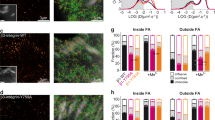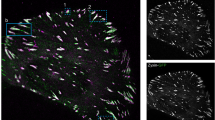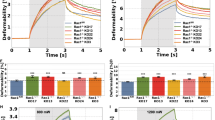Abstract
Cell spreading, adhesion and remodelling of the extracellular matrix (ECM) involve bi-directional signalling and physical linkages between the ECM, integrins and the cell cytoskeleton1,2,3. The actin-binding proteins talin1 and 2 link ligand-bound integrins to the actin cytoskeleton and increase the affinity of integrin for the ECM4,5,6. Here we report that depletion of talin2 in talin1-null (talin1−/−) cells did not affect the initiation of matrix-activated spreading or Src family kinase (SFK) activation, but abolished the ECM–integrin–cytoskeleton linkage and sustained cell spreading and adhesion. Specifically, focal adhesion assembly, focal adhesion kinase (FAK) signalling and traction force generation on substrates were severely affected. The talin1 head domain restored β1 integrin activation but only full-length talin1 restored the ECM–cytoskeleton linkage and normal cytoskeleton organization. Our results demonstrate three biochemically distinct steps in fibronectin-activated cell spreading and adhesion: 1) fibronectin–integrin binding and initiation of spreading, 2) fast cell spreading and 3) focal adhesion formation and substrate traction. We suggest that talin is not required for initial cell spreading. However, talin provides the important mechanical linkage between ligand-bound integrins and the actin cytoskeleton required to catalyse focal adhesion-dependent pathways.
This is a preview of subscription content, access via your institution
Access options
Subscribe to this journal
Receive 12 print issues and online access
$209.00 per year
only $17.42 per issue
Buy this article
- Purchase on Springer Link
- Instant access to full article PDF
Prices may be subject to local taxes which are calculated during checkout





Similar content being viewed by others
References
Sheetz, M. P., Felsenfeld, D., Galbraith, C. G. & Choquet, D. Cell migration as a five-step cycle. Biochem. Soc. Symp. 65, 233–243 (1999).
DeMali, K. A., Wennerberg, K. & Burridge, K., Integrin signaling to the actin cytoskeleton. Curr. Opin. Cell Biol. 15, 572–582 (2003).
Shattil, S. J., Integrins and Src: dynamic duo of adhesion signaling. Trends Cell Biol. 15, 399–403 (2005).
Critchley, D. R. & Gingras, A. R., Talin at a glance. J. Cell Sci. 121, 1345–1347 (2008).
Jiang, G. et al. Two-piconewton slip bond between fibronectin and the cytoskeleton depends on talin. Nature 424, 334–337 (2003).
Calderwood, D. A. et al. The Talin head domain binds to integrin β subunit cytoplasmic tails and regulates integrin activation. J. Biol. Chem. 274, 28071–28074 (1999).
Priddle, H. et al. Disruption of the talin gene compromises focal adhesion assembly in undifferentiated but not differentiated embryonic stem cells. J. Cell Biol. 142, 1121–1133 (1998).
Monkley, S. J., Pritchard, C. A. & Critchley, D. R., Analysis of the mammalian talin2 gene TLN2. Biochem. Biophys. Res. Commun. 286, 880–885 (2001).
Small, J. V., Rottner, K., Kaverina, I. & Anderson, K. I., Assembling an actin cytoskeleton for cell attachment and movement. Biochim. Biophys. Acta 1404, 271–281 (1998).
Bear, J. E. et al. Antagonism between Ena/VASP proteins and actin filament capping regulates fibroblast motility. Cell 109, 509–521 (2002).
Tadokoro, S. et al. Talin binding to integrin beta tails: a final common step in integrin activation. Science 302, 103–106 (2003).
Tanentzapf, G. & Brown, N. H., An interaction between integrin and the talin FERM domain mediates integrin activation but not linkage to the cytoskeleton. Nature Cell Biol. 8, 601–606 (2006).
Moes, M. et al. The integrin binding site 2 (IBS2) in the talin rod domain is essential for linking integrin β subunits to the cytoskeleton. J. Biol. Chem. 282, 17280–17288 (2007).
Lenter, M. et al. A monoclonal antibody against an activation epitope on mouse integrin chain beta 1 blocks adhesion of lymphocytes to the endothelial integrin α6 β1. Proc. Natl Acad. Sci. USA 90, 9051–9055 (1993).
Galbraith, C. G., Yamada, K. M. & Galbraith, J. A., Polymerizing actin fibers position integrins primed to probe for adhesion sites. Science 315, 992–995 (2007).
Schlaepfer, D. D., Hauck, C. R. & Sieg, D. J., Signaling through focal adhesion kinase. Prog. Biophys. Mol. Biol. 71, 435–478 (1999).
von Wichert, G. et al. RPTP-α acts as a transducer of mechanical force on α5/β3-integrin-cytoskeleton linkages. J. Cell Biol. 161, 143–153 (2003).
Di Florio, A. et al. Src family kinase activity regulates adhesion, spreading and migration of pancreatic endocrine tumour cells. Endocr. Relat. Cancer 14, 111–124 (2007).
Borowsky, M. L. & Hynes, R. O., Layilin, a novel talin-binding transmembrane protein homologous with C-type lectins, is localized in membrane ruffles. J. Cell Biol. 143, 429–442 (1998).
Sawada, Y. & Sheetz, M. P., Force transduction by Triton cytoskeletons. J. Cell Biol. 156, 609–625 (2002).
Bershadsky, A. D. et al. Assembly and mechanosensory function of focal adhesions: experiments and models. Eur. J. Cell Biol. 85, 165–173 (2006).
Giannone, G. et al. Periodic lamellipodial contractions correlate with rearward actin waves. Cell 116, 431–443 (2004).
Hotulainen, P. & Lappalainen, P., Stress fibers are generated by two distinct actin assembly mechanisms in motile cells. J. Cell Biol. 173, 383–394 (2006).
Burton, K., Park, J. H. & Taylor, D. L., Keratocytes generate traction forces in two phases. Mol. Biol. Cell 10, 3745–3765 (1999).
Burnette, D. T. et al. Filopodial actin bundles are not necessary for microtubule advance into the peripheral domain of Aplysia neuronal growth cones. Nature Cell Biol. 9, 1360–1369 (2007).
Moser, M. et al. Kindlin-3 is essential for integrin activation and platelet aggregation. Nature Med. 14, 325–330 (2008).
Dubin-Thaler, B. J., Giannone, G., Dobereiner, H. G. & Sheetz, M. P., Nanometer analysis of cell spreading on matrix-coated surfaces reveals two distinct cell states and STEPs. Biophys. J. 86, 1794–1806 (2004).
Bailly, M., Condeelis, J. S. & Segall, J. E., Chemoattractant-induced lamellipod extension. Microsc. Res. Tech. 43, 433–443 (1998).
Ponti, A. et al. Two distinct actin networks drive the protrusion of migrating cells. Science 305, 1782–1786 (2004).
Hu, K. et al. Differential transmission of actin motion within focal adhesions. Science 315, 111–115 (2007).
Acknowledgements
We thank P. De Camilli for talin2-specific antibody, N. Bate for various talin1 constructs and A.J. Woods for the talin1ABS construct. We thank N. Gauthier, T. Perez and O. Rossier for helpful discussions, and the continuing help from all members of the Sheetz laboratory. Work in the laboratory of M.P.S. was supported by the National Institutes of Health through the NIH Roadmap for Medical Research (PN2 EY016586) and X.Z. was supported by GM-003267. Work in the D.R.C. laboratory was funded by the Wellcome Trust.
Author information
Authors and Affiliations
Contributions
X.Z. performed all the experiments in M.P.S. lab with significant support from G.J. and Y.C.; S.J.M. provided the cell line and important information; D.R.C. provided important direction on the project.
Corresponding author
Ethics declarations
Competing interests
The authors declare no competing financial interests.
Supplementary information
Supplementary Information
Supplementary Figures S1, S2, S3, S4, S5, S6 and S7 (PDF 894 kb)
Supplementary Information
Supplementary Movie 1 (MOV 1260 kb)
Supplementary Information
Supplementary Movie 2 (MOV 2818 kb)
Supplementary Information
Supplementary Movie 3 (MOV 1810 kb)
Supplementary Information
Supplementary Movie 4 (MOV 2524 kb)
Supplementary Information
Supplementary Movie 5 (MOV 2707 kb)
Supplementary Information
Supplementary Movie 6 (MOV 720 kb)
Supplementary Information
Supplementary Movie 7 (MOV 1340 kb)
Supplementary Information
Supplementary Movie 8 (MOV 2915 kb)
Supplementary Information
Supplementary Movie 9 (MOV 1094 kb)
Supplementary Information
Supplementary Movie 10 (MOV 2455 kb)
Rights and permissions
About this article
Cite this article
Zhang, X., Jiang, G., Cai, Y. et al. Talin depletion reveals independence of initial cell spreading from integrin activation and traction. Nat Cell Biol 10, 1062–1068 (2008). https://doi.org/10.1038/ncb1765
Received:
Accepted:
Published:
Issue Date:
DOI: https://doi.org/10.1038/ncb1765
This article is cited by
-
HDAC1/2 control mesothelium/ovarian cancer adhesive interactions impacting on Talin-1-α5β1-integrin-mediated actin cytoskeleton and extracellular matrix protein remodeling
Journal of Experimental & Clinical Cancer Research (2024)
-
Talin2 and KANK2 functionally interact to regulate microtubule dynamics, paclitaxel sensitivity and cell migration in the MDA-MB-435S melanoma cell line
Cellular & Molecular Biology Letters (2023)
-
Hydrogel dressing integrating FAK inhibition and ROS scavenging for mechano-chemical treatment of atopic dermatitis
Nature Communications (2023)
-
Mechanically active integrins target lytic secretion at the immune synapse to facilitate cellular cytotoxicity
Nature Communications (2022)
-
Rear traction forces drive adherent tissue migration in vivo
Nature Cell Biology (2022)



